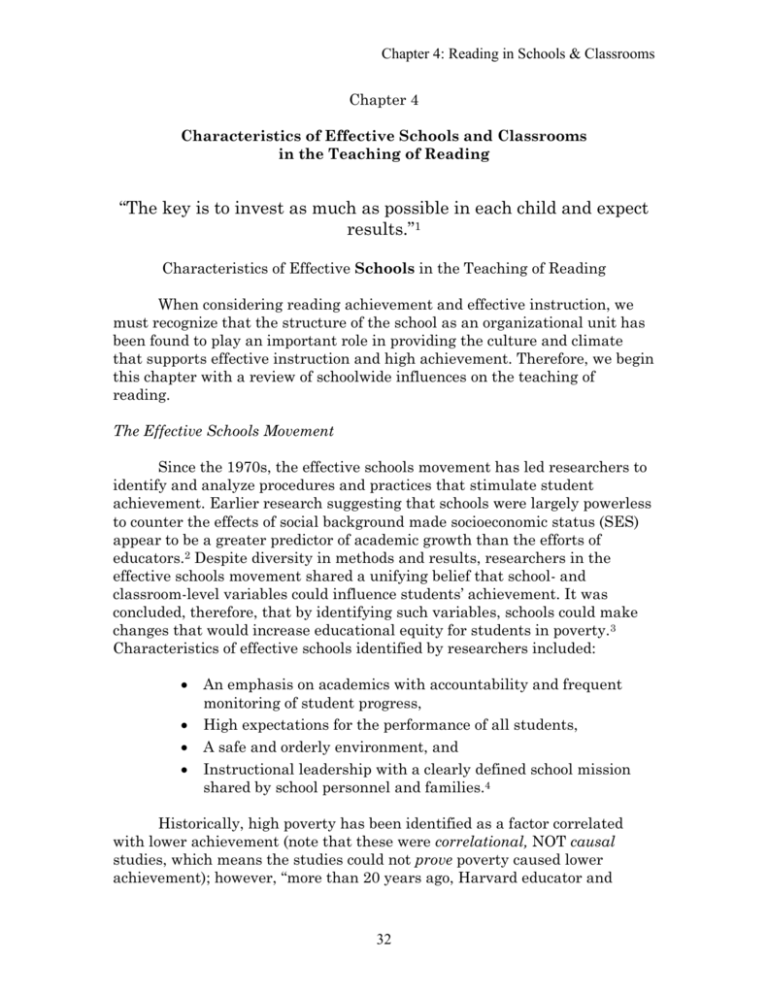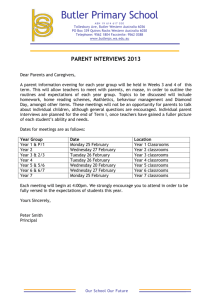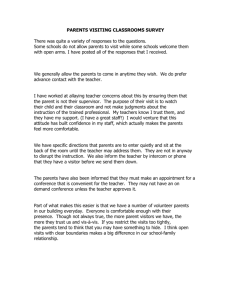Chapter 4 - Characteristics of Effective Schools and Classrooms in
advertisement

Chapter 4: Reading in Schools & Classrooms Chapter 4 Characteristics of Effective Schools and Classrooms in the Teaching of Reading “The key is to invest as much as possible in each child and expect results.”1 Characteristics of Effective Schools in the Teaching of Reading When considering reading achievement and effective instruction, we must recognize that the structure of the school as an organizational unit has been found to play an important role in providing the culture and climate that supports effective instruction and high achievement. Therefore, we begin this chapter with a review of schoolwide influences on the teaching of reading. The Effective Schools Movement Since the 1970s, the effective schools movement has led researchers to identify and analyze procedures and practices that stimulate student achievement. Earlier research suggesting that schools were largely powerless to counter the effects of social background made socioeconomic status (SES) appear to be a greater predictor of academic growth than the efforts of educators.2 Despite diversity in methods and results, researchers in the effective schools movement shared a unifying belief that school- and classroom-level variables could influence students’ achievement. It was concluded, therefore, that by identifying such variables, schools could make changes that would increase educational equity for students in poverty.3 Characteristics of effective schools identified by researchers included: An emphasis on academics with accountability and frequent monitoring of student progress, High expectations for the performance of all students, A safe and orderly environment, and Instructional leadership with a clearly defined school mission shared by school personnel and families.4 Historically, high poverty has been identified as a factor correlated with lower achievement (note that these were correlational, NOT causal studies, which means the studies could not prove poverty caused lower achievement); however, “more than 20 years ago, Harvard educator and 32 Chapter 4: Reading in Schools & Classrooms researcher Ron Edmonds asked, ‘How many effective schools would you have to see to be persuaded of the educability of poor children?’”5 Despite the odds, over the years, researchers have identified highachieving, high-poverty schools. A growing body of literature supports the position that all children can achieve, including students who have traditionally failed to reach established standards. For example, over 4500 high-poverty and high-minority schools with reading and/or math achievement in the top third of all schools in their state have been identified and the numbers are growing with data being collected in the American Institutes for Research database.6 (Note: Interstate comparisons cannot be made due to differences in achievement measures, standards, and diversity of demographics.) High-Poverty Effective Schools and Reading Several studies have examined the characteristics of schools within high-poverty contexts that have been successful in supporting students’ reading achievement. For example, The Longitudinal Evaluation of School Change and Performance (LESCP) in Title I schools examined student achievement from third through fifth grade in 71 high-poverty schools. The study found: Most students did not catch up with peers in more affluent communities. Active outreach to parents was associated with 50% greater growth. High teacher rating of their professional development in reading led to 20% greater growth7 in students’ reading achievement. (Limitations of this study included a lack of reported effect sizes and reliance on teacher self-report.) An earlier longitudinal study found evidence to support the claim that students at risk of academic failure could succeed and reach national norms,8 suggesting that schools that focused on primary grades instead of the full elementary-grade spectrum produced larger gains in achievement.9 The recommendation that focusing quality instruction on kindergarten and the primary grades is the single best weapon against reading failure was reiterated by Snow and her associates.10 Other school-level factors in high-poverty schools that have been associated with higher academic performance include: Lower-than-average teacher and student mobility (schools and classrooms that do not meet the focus of this review), Experienced principals, and 33 Chapter 4: Reading in Schools & Classrooms An orderly school environment.11 Looking at school-based initiatives to teach reading to at-risk and delayed readers, Gaskins delineated four elements associated with improved student reading: Meaningful, targeted, and ongoing professional development, Quality instruction and support services, Congruence between remedial and regular programs, and Sufficient instructional time.12 The Center for Improvement of Early Reading Achievement (CIERA) has conducted a number of studies in high-poverty schools that incorporate the effective schools research as a framework for analyzing reading achievement. Using the increasing data on high-achieving, high-poverty schools, researchers at CIERA studied 14 high-poverty schools. Other characteristics of participating schools included high mobility and significant number of students with limited English proficiency in half of the schools. Using structured interviews with principals and reading staff, classroom observations with a structured ecological data collection system, field notes, informal observations, and selected artifacts, the following recurring themes were identified across several separate school studies as school features associated with greater student growth in reading:13 1. Schools emphasized putting students first to improve learning with less emphasis on a particular instructional approach. There was a collective sense of responsibility for all students. The schools reported that commitment and hard work focused on research-based practices at the school and classroom level were more critical factors to success than packaged programs. 2. Schools had strong building leadership with principals filling the role of instructional leaders, not just managers. Leadership that was highly collaborative and included teachers as leaders was also related to higher reading fluency and writing skills. There was a sense of high self-efficacy with experienced, knowledgeable staff. The level of trust and respect among the staff allowed room for risk-taking and innovation in meeting student needs and helping each other learn more about the art and science of teaching.14 3. Strong teacher collaboration, communication, and collegiality were evident. 4. The schools made professional development and innovation a priority in supporting teachers and their instruction. 34 Chapter 4: Reading in Schools & Classrooms 5. Systematic assessment of pupil progress was ongoing, with staff consistently using student performance data to improve learning. These data were the foundation for planning instruction.15 6. Schools had strong, deliberate communication links to parents.16 (Note: Many of these research endeavors also included an analysis of effective classroom practices, which will be described in the next section.) Characteristics of Effective Classrooms in the Teaching of Reading Schools can create communities that increase the likelihood that effective instruction and learning will occur; however, the point of actual instruction occurs in the classroom with the teacher (or in a supplemental program with a tutor or reading specialist). “Traditionally, low-achieving students have received predominantly skill-and-drill instruction. Higher order thinking strategies have been directed more often at the instruction of the more intellectually capable students.”17 This trend runs counter to findings such as those noted in a two-year study of 140 high-poverty firstthrough sixth-grade classrooms in 15 schools, 18 which found that effective instruction was associated with a greater emphasis on higher-order thinking than lower-level drill-and-practice.19 Other research suggests higher achievement is possible when reading and writing are integrated, students discuss what they read, teachers emphasize deep understanding rather than literal comprehension of texts, and reading occurs in context rather than relying on discrete skill instruction.20 Research on effective teaching that studied the habits of exemplary teachers noted many parallels with the National Reading Panel’s call for a balanced reading program.21 As discussed in the previous section, CIERA researchers also looked at instructional practices at the classroom level. Specifically, CIERA studies applied the process-product approach of neobehaviorism to instruction to reading with its focus on direct instruction and mastery teaching22 and blended later work that looked beyond direct instruction with a greater emphasis on teacher thinking.23 While both approaches used similar strategies, the latter approach to direct instruction included more teacher modeling and overt description of processes employed during the reading process. In developing their studies, the researchers at CIERA considered the findings of earlier studies, such as the Center on English Learning & Achievement (CELA), which observed first-grade teachers in urban settings. The most effective teachers were identified based on reading and writing scores.24 These teachers “demonstrated instructional balance, focusing on both literature and skills. They taught decoding skills explicitly and also provided their students with many opportunities to engage in authentic, integrated reading and writing activities.”25 The most effective teachers also used 35 Chapter 4: Reading in Schools & Classrooms scaffolding, developed self-regulation and self-monitoring strategies for students to take responsibility for their own learning, work quality, and work time. Furthermore, they established high expectations for students and were masters at classroom management, smoothly integrating consistent procedures and routines to enhance organization and efficiency. In comparison, the less effective teachers tended to focus on just skills or just whole language, or combined the two in disjointed ways. The following table compares the findings related to first-grade teacher behaviors across four studies spanning nearly three decades. 36 Chapter 4: Reading in Schools & Classrooms Study/ Stalling & Kaskowitz, 1974 Anderson et al., 197926 CELA, 1998 & 200127 CIERA, 2000, 2002 Spent more time in reading groups X X X X Used intensive smallgroup instruction for lowest SES X X Teacher Behaviors X Engaged in more active instruction (students were less passive) Demonstrated strong classroom management/student engagement X Followed up with students who provided incorrect responses to assist students in improving their answers; coaching vs. didactic response X X X X X X X Spent time in independent reading X X Strong home communication X X More higher-level comprehension questions X X Encouraged selfregulation/monitoring X Explicit instruction and modeling of multiple strategies X X Frequent opportunities to read, write, and talk about text; emphasis on literacy as effective communication X X Table 3. Effective First-Grade Reading Practices in High-Poverty Schools 37 Chapter 4: Reading in Schools & Classrooms The CIERA studies included first- through sixth-grade classrooms. As noted for first grade, effective teachers exhibited excellent classroom management, provided scaffolding to support new learning, balanced literacy instruction, asked higher-level questions, explicitly taught skills and strategies, and offered frequent opportunities to read, write, and talk about text. Additional findings regarding classroom characteristics and teacher behaviors are listed below. Teachers used multiple reading programs in every classroom (e.g., Project READ and Reading Recovery); Flexible grouping throughout the grades allowed students to move among groups based on changing needs and interests (such decisions were made jointly by staff who met frequently to discuss student needs, reflecting joint ownership and the ability to identify and solve problems); There were extensive collections of trade books in the classrooms; and A variety of supplemental supports were available to students, including tutoring after school, summer programs, additional smallgroup instruction. Also, classrooms in several schools worked with local universities on collaborative projects related to reading. The effectiveness of some classroom practices varied based on the grade level being taught. For example: For grades 2 through 6, achievement was higher when students had to respond actively and lower in classrooms where teachers tended to tell students information and involve them in recitation. Heavy reliance on phonics instruction was negatively related to reading growth in kindergarten and grades 2 and 3. A high level of phonemic awareness instruction was positively related to growth in phonemic segmentation and blending in kindergarten. In grades 4 through 6, coaching students in the use of wordrecognition strategies during reading was positively related to student growth compared to telling students the word or simply saying, “Sound it out.” Small-group instruction was positively related to growth in kindergarten and first grade whereas large-group instruction was positively related to reading growth in the upper-elementary grades (4-6). 38 Chapter 4: Reading in Schools & Classrooms The studies reviewed in this chapter highlight many general practices in schools and classrooms that support academic achievement and begin to target how these general practices influence reading instruction and learning. The next chapter will look more closely at the specifics of effective reading instruction that is likely to lead to student success. Endnotes for Chapter 4 1 Anderson, F. (2003). An after-school tutoring program for at-risk and homeless children: Instructions for set-up and program delivery. Kenosha, WI: Kenosha Unified School District. 2 See Bickel, W. E., & Bickel, D. D. (1986) Effective schools, classrooms, and instruction: Implications for special education. Exceptional children, 52, 489-500; and Coleman, J. S., Campbell, E. Q., Hobson, C. J., McPartland, J. M., Mood, A. M., Weinfeld, F. D., & York, R. L. (1966). Equality of educational opportunity. Washington, DC: National Center for Educational Statistics, Office of Education. 3 Greenwood, C. R., Delquadri, J. C., Stanely, S. O., Terry, B., & Hall, R. V. (1986). Performance-based assessment of depriving environments: Computation of context/response interactions within inner-city and suburban school settings. In S. E. Newstead, S. H. Irvine, & P. D. Dan (Eds.), Human assessment: Cognition and motivation (pp. 319-340). Dordrecht, The Netherlands: Nijhoff Press. 4 See, for example, Bickel & Bickel. (1986); Butler, J. A., & Dickson, K. M. (1997). Improving school culture: Centennial High School. Retrieved November 18, 2000 from, http://www.nwrel.org/pcpd/sirs/1/snap2.html; Edmonds, R. (1982). Programs of school improvement: An overview. Educational Leadership,4(3), 4-11; Shields, P. M., Knapp, M. S., & Wechsler, M. E. (1995). Improving schools from the bottom up: From effective schools to restructuring. Washington, DC: U.S. Government Printing Office. 5 Jerald, C. D. (2001). Dispelling the myth revisited: Preliminary findings from a nationwide analysis of “high flying” schools. Washington, DC: Education Trust, p. 6. 6 Ibid. 7 Westat and Policy Studies Associates. (2001). The longitudinal evaluation of school change and performance (LESCP) in Title I schools. Final Report, Volume I: Executive Summary. Author: Washington, DC, (ED 457305). Retrieved July 29, 2003 from http://www.ed.gov/offices.OUS/PES/eval.html. 8 Ibid. 9 Stringfield, S., Millsap, M. A., & Herman, R. (1997). Urban and suburban/rural special strategies for educating disadvantaged children: Findings and policy implications of a longitudinal study. Washington, DC: U. S. Department of Education. 10 Snow, Burns & Griffin. (2001). pp. 5-6. 11 Puma, M. J., Karweit, N., Price, C., Ricciuti, A., Thompson, W., & Vaden-Kiernan, M. (1997). Prospects: Final report on student outcomes. Washington, DC: U.S. Department of Education, Planning and Evaluating Service. 12 Gaskins, I. (1998). There’s more to teaching at-risk and delayed readers than good reading instruction. The Reading Teacher, 51(7), 534-547. p. 535. 13 Taylor, B. M., & Pearson, P. D. (2002). The CIERA school change project: Supporting schools as they implement home-grown reading reform. (ED468690). Retrieved July 29, 2003, from http://www.ciera.org. See also Alder, M. A., & Fisher, C. W. (2001). Center for the improvement of early reading achievement: Early reading programs in high-poverty schools: A case study of beating the odds. The Reading Teacher, 54(6), 616-619. 14 Taylor, B. M., Pressley, M., & Pearson, P. D. (2000). Effective teachers and schools: Trends across recent studies. Retrieved July 29, 2003from Ovid, (ED450353). CIERA. 15 Ibid. 16 Taylor, B. M., Pearson, P. D., Clark, K., & Walpole, S. (2000). Effective schools and accomplished teachers: Lessons about primary-grade reading instruction in low-income schools. The Elementary School Journal,101(2), 121-165. 17 Brookbank, D. Grover, S, Kullberg, K., & Strawser, C. (1999). Improving student achievement through organization of student learning. (ED435094), p. 24; and Knapp, M. S., Shields, P. M., & Turnbull, B. J. 39 Chapter 4: Reading in Schools & Classrooms (1993). Academic challenge for the children of poverty: The summary report (ERS Item #171). Arlington, VA: Educational Research Service. 18 Taylor et al. (2000). p. 125. 19 Knapp et al. (1995). 20 Duffy, G. G., Roehler, L. R., Sivan, E., Rackliffe, G., Book, C., Meloth, M. S., Vavrus, L. G., Wesselman, R., Putnam, J., & Bassiri, D. (1987). Effects of explaining the reasoning associated with using reading strategies. Reading Research Quarterly, 20, 347-368. 21 The National Reading Panel Report is available at www.nationalreadingpanel.org. 22 Carnine, D. W., Silbert, J. & Kameenui, E. J. (1997). Direct instruction reading (3rd ed.). Upper Saddle River, NJ: Merrill-Prentice Hall. 23 Duffy et al. (1987). 24 Taylor, B. M., Pearson, P. D., Clark, K., & Walpole, S. (2000). 25 Ibid., p. 125. 26 Andserson, L., Evertson, C., & Brophy, J. (1979). An experimental student of effective teaching in firstgrade reading groups. Elementary School Journal, 79, 193-223. 27 Pressley, M, Wharton-McDonald, R., Allington, R., Block, C., Morrow, L., Tracey, D., Baker, K., Brooks, G., Cronin, J., Nelson, E., & Woo, D. (2001). A study of effective first-grade literacy instruction. Scientific Studies of Reading, 5, 35-58. 40






